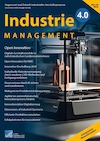Search


Bibtex
Cite as text
@Article{Motzki+Hau+Schmidt+Seelecke+,
Year= "2018",
Number= "4",
Volume= "34",
Pages= "38-41",
Journal = "Industrie 4.0 Management",
Title= "Künstliche Muskeln und Nerven in Industrie 4.0 Konzepten: Multifunktionale Aktor-Sensor-Systeme mit Formgedächtnislegierungen und dielektrischen Elastomeren",
Author= "Paul {Motzki}, Steffen {Hau}, Marvin {Schmidt} und Stefan {Seelecke}",
Doi= "https://doi.org/10.30844/I40M18-4_38-41",
Abstract= "Innerhalb der Konzepte von Industrie 4.0 steht der Begriff Smart Factory für die Schaffung von effektiven Produktionsumgebungen durch Digitalisierung und Cyber-Physische Systeme. Fertigungsanlagen sollen stärker automatisiert, flexibel und adaptiv werden. Im Zuge dieser Bestrebungen geraten auch intelligente Materialien immer mehr in den Fokus der Industrie. Kombinierte aktorische und sensorische Eigenschaften ermöglichen den Aufbau leichter und kompakter multifunktionaler Aktor-Sensor-Systeme, welche zudem energieeffizient, geräusch- und emissionslos betrieben werden. Dadurch bieten sie sich insbesondere für den Aufbau vernetzter Systeme an. Speziell Formgedächtnislegierungen (FGL) und dielektrische Elastomere (DE) eignen sich für den Aufbau intelligenter Aktoren und werden anhand von einigen Anwendungsbeispielen in diesem Beitrag vorgestellt.",
Keywords= "Intelligente Materialien, Formgedächtnislegierungen, FGL, dielektrische Elastomere, DEA",
}
Paul {Motzki}, Steffen {Hau}, Marvin {Schmidt} und Stefan {Seelecke}(2018): Künstliche Muskeln und Nerven in Industrie 4.0 Konzepten: Multifunktionale Aktor-Sensor-Systeme mit Formgedächtnislegierungen und dielektrischen Elastomeren. 344(2018), S. 38-41. Online: https://doi.org/10.30844/I40M18-4_38-41 (Abgerufen 24.12.25)
Open Access
Abstract
Abstract
Innerhalb der Konzepte von Industrie 4.0 steht der Begriff Smart Factory für die Schaffung von effektiven Produktionsumgebungen durch Digitalisierung und Cyber-Physische Systeme. Fertigungsanlagen sollen stärker automatisiert, flexibel und adaptiv werden. Im Zuge dieser Bestrebungen geraten auch intelligente Materialien immer mehr in den Fokus der Industrie. Kombinierte aktorische und sensorische Eigenschaften ermöglichen den Aufbau leichter und kompakter multifunktionaler Aktor-Sensor-Systeme, welche zudem energieeffizient, geräusch- und emissionslos betrieben werden. Dadurch bieten sie sich insbesondere für den Aufbau vernetzter Systeme an. Speziell Formgedächtnislegierungen (FGL) und dielektrische Elastomere (DE) eignen sich für den Aufbau intelligenter Aktoren und werden anhand von einigen Anwendungsbeispielen in diesem Beitrag vorgestellt.
Keywords
Schlüsselwörter
Intelligente Materialien, Formgedächtnislegierungen, FGL, dielektrische Elastomere, DEA
References
Referenzen
[1] Janocha, H.: Adaptronics and Smart Structures. Basics, Materials, Design, and Applications. Berlin Heidelberg 2007.
[2] Lagoudas, D.C.: Shape Memory Alloys: Modeling and Engineering Applications. New York 2008.
[3] SAES Getters. SmartFlex Brochure 2017. URL: https://www.saesgetters.com/sites/default/files/SmartFlex Brochure_2.pdf, Abrufdatum 01.03.2018.
[4] Dynalloy Inc. Technical Characteristics of Flexinol Actuator Wires 2017. URL: http://www.dynalloy.com/pdfs/TCF1140.pdf, Abrufdatum 01.03.2018.
[5] Janocha, H.: Unkonventionelle Aktoren – Eine Einführung. München 2013.
[6] Hollerbach, J.M.; Hunter, I.W.; Ballantyne, J.A.: Comparative analysis of actuator technologies for robotics. In: The Robotics Review (1992) 2, S. 299-342.
[7] Motzki, P.; Gorges, T.; Würtz, T.; Seelecke, S.: Experimental Investigation of High-Speed/High-Voltage SMA Actuation. In: ASME 2017 Conference on Smart Materials, Adaptive Structures and Intelligent Systems. Snowbird USA 2017.
[8] Motzki, P.; Gorges, T.; Seelecke, S.: Hoch-Volt Ansteuerung: Ultraschnelle FGL-Aktorik. In: VDI-Expertenforum: Smart Materials – kompakte, intelligente Systeme für eine innovative Industrie. Potsdam 2016.
[9] Actuator Solutions GmbH: Actuator Solutions SMA Products 2018. URL: http://www.actuatorsolutions.de/products/, Abrufdatum 01.03.2018.
[10] Köpfer, M.: Industrialisierung der FGL-Technologie in hochvolumigen Serienprodukt. In: VDI-Expertenforum: Smart Materials – Aus der Forschung in die industrielle Anwendung. Potsdam 2017.
[11] Theiß, R.; Czechowicz, A.; Dültgen, P.: Industry 4.0 using shape memory actuators – opportunities and challenges. In Conference: Actuator 2016. Bremen.
[12] Motzki, P.; Seelecke, S.: Bistabile Aktorvorrichtung mit einem Formgedächtniselement. 2016.
[13] Motzki, P.; Seelecke, S.: Bistable Actuator Device Having A Shape Memory Element. 2016.
[14] Seelecke, S.: Thermische Formgedächtnislegierungen – vom Werkstoff auf dem Weg zum Produkt. In: VDI-Expertenforum: Smart Materials – Aus der Forschung in die industrielle Anwendung. Potsdam 2017.
[15] Khelfa, F.; Zimmer, L.; Motzki, P.; Seelecke, S.: Development of a Reconfigurable End-Effector Prototype. In: ASME 2017 Conference on Smart Materials, Adaptive Structures and Intelligent Systems. Snowbird USA 2017.
[16] Simone, F. Rizzello, G.; Seelecke, S.: Metal muscles and nerves – A self-sensing SMA-actuated hand concept. In: Smart Materials and Structures 26 (2017) 9. S. 095007.
[17] Pelrine, R.E.; Kornbluh, R.D.; Joseph, J.P.: Electrostriction of polymer dielectrics with compliant electrodes as a means of actuation. In: Sensors and Actuators A: Physical 64 (1998) 1, S. 77-85.
[18] Carpi, F.; De Rossi, D.; Kornbluh, R.D.; Pelrine, R.E.; Sommer-Larsen, P.: Dielectric Elastomers as Electromechanical Transducers: Fundamentals, Materials, Devices, Models and Applications of an Emerging Electroactive Polymer Technology. Amsterdam 2008.
[19] Parker-Hannifin, “Sensor Datasheet EAPS-50RT/100RT,” p. 2 [Online]. Available: http://promo.parker.com/promotionsite/eap/us/en/products/Sensors. [Accessed: 23-Feb-2018].
[20] O’Brien, B.; Gisby, T.; Anderson, I.A.: Stretch sensors for human body motion. In: Proceedings of SPIE 9056 – The International Society for Optical Engineering 2014, S. 905618.
[21] York, A.; Dunn, J.; Seelecke, S.: Systematic approach to development of pressure sensors using dielectric electro-active polymer membranes. In: Smart Materials and Structures 22 (2013) 9. S. 094015.
[22] Koh, S.J.A.; Keplinger, C.; Li, T.; Bauer, S.; Suo, Z.: Dielectric Elastomer Generators: How Much Energy Can Be Converted? In: IEEE/ASME Transactions on Mechatronics 16 (2011) 1, S. 33-41.
[23] Zanini, P.; Rossiter, J.; Homer, M.: Self-stabilizing dielectric elastomer generators. In: Smart Materials and Structures 26 (2017) 3. S. 035037.
[24] McKay, T.G.; Rosset, S.; Anderson, I.A.; Shea, H.R.: Dielectric elastomer generators that stack up. In: Smart Materials and Structures 24 (2017) 1. S. 015014.
[25] O’Halloran, A.; O’Malley, F.; McHugh, P.: A review on dielectric elastomer actuators, technology, applications, and challenges. In: Journal of Applied Physics 104 (2008) 7. S. 071101.
[26] Pelrine, R.E.; Sommer-Larsen, P.; Kornbluh, R.D.; Heydt, R.; Kofod, G.; Pei, Q.; et al.: Applications of dielectric elastomer actuators. In: Bar-Cohen, Y (Hrsg): Smart structures and materials 2001: Electroactive polymer actuators and devices. Bellingham 2001, S. 335-349.
[27] Bar-Cohen, Y.: Electroactive Polymers as Artificial Muscles: Capabilities, Potentials and Challenges. Reston 2000, S. 188-196.
[28] Maas, J.; Tepel, D.; Hoffstadt, T.: Actuator design and automated manufacturing process for DEAP-based multilayer stack-actuators. In: Meccanica 50 (2015) 11, S. 2839-2854.
[29] Haus, H.; Matysek, M.; Mößinger, H.; Schlaak, H.F.: Modelling and characterization of dielectric elastomer stack actuators. In: Smart Materials and Structures 22 (2013) 10. S. 104009.
[30] Kovacs, G.; Düring, L.; Michel, S.; Terrasi, G.: Stacked dielectric elastomer actuator for tensile force transmission. Sensors and Actuators A: Physical 155 (2009) 2, S. 299-307.
[31] Hau, S.; Bruch, D.; Rizzello, G.; Motzki, P.; Seelecke, S.: Silicone based dielectric elastomer strip actuators coupled with non-linear biasing elements for large actuation strains. 2018.
[32] Hau, S.; York, A.; Seelecke, S.: High-Force Dielectric Electroactive Polymer (DEAP) membrane actuator. In: Bar-Cohen, Y; Vidal, F. (Hrsg): Proceedings SPIE 9798, Electroactive Polymer Actuators and Devices (EAPAD). Las Vegas 2016.
[33] Rizzello, G.; Naso, D.; York, A.; Seelecke, S.: Closed loop control of dielectric elastomer actuators based on self-sensing displacement feedback. In: Smart Materials and Structures 25 (2016) 3. S. 035034.
[34] Rosset, S.; O’Brien, B.M.; Gisby, T.; Xu, D.; Shea, H.R.; Anderson, I.A.: Self-sensing dielectric elastomer actuators in closed-loop operation. In: Smart Materials and Structures 22 (2013) 10. S. 104018.
[35] Rosset, S.; de Saint-Aubin, C.; Poulin, A.; Shea, H.R.: Assessing the degradation of compliant electrodes for soft actuators. In: Review of Scientific Instruments 88 (2017) 10, S. 105002.
[36] Hill, M.; Rizzello, G.; Seelecke, S.: Development of a fatigue testing setup for dielectric elastomer membrane actuators. In: Conference: SPIE Smart Structures and Materials+ Nondestructive Evaluation and Health Monitoring 2017.
[37] Matysek, M.; Lotz, P.; Schlaak, H.: Lifetime investigation of dielectric elastomer stack actuators. In: IEEE Transactions on Dielectrics and Electrical Insulation 18 (2011) 1, S. 89-96.
[38] Optotune, “Products” [Online]. Available: http://www.optotune.com/products. [Accessed: 06-Jan-2018].
[39] Giousouf, M., and Kovacs, G., 2013, “Dielectric Elastomer Actuators Used for Pneumatic Valve Technology,” Smart Mater. Struct, 22, pp. 104010–6, doi: 10.1088/0964-1726/22/10/104010.
[40] Hill, M.; Rizzello, G.; Seelecke, S.: Development and experimental characterization of a pneumatic valve actuated by a dielectric elastomer membrane. In: Smart Materials and Structures 26 (2017) 8. S. 085023.
[41] Bonci, A.; Longhi, S.; Pirani, M.; Lorenzoni, E.; Rizzello, G.; Naso, D.; Seelecke, S.: Simulation Analysis and Performance Evaluation of a Vibratory Feeder Actuated by Dielectric Elastomers. In: The 14th IEEE/ASME International Conference on Mechatronic and Embedded Systems and Applications. 2018. pp.1-6.

 English
English